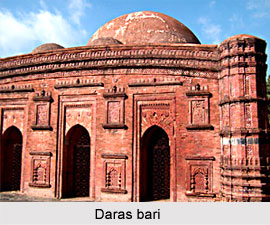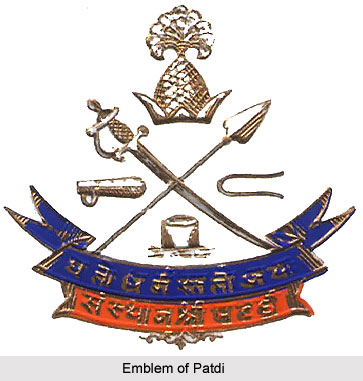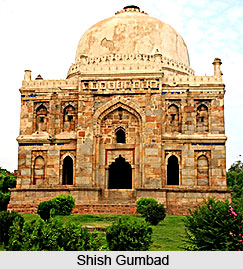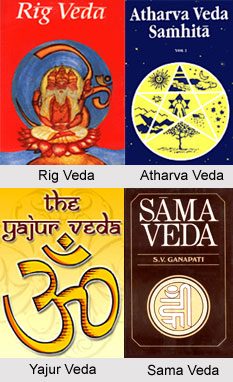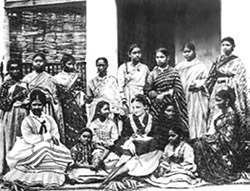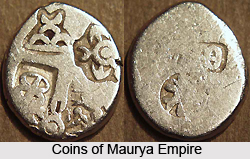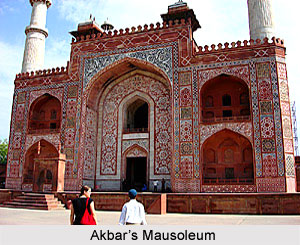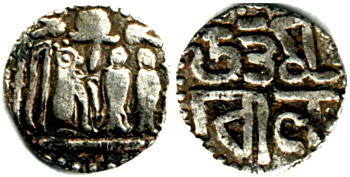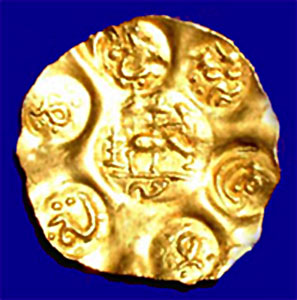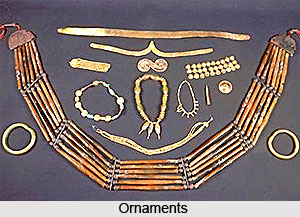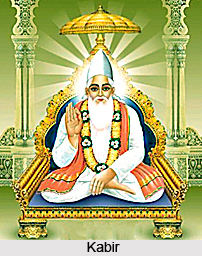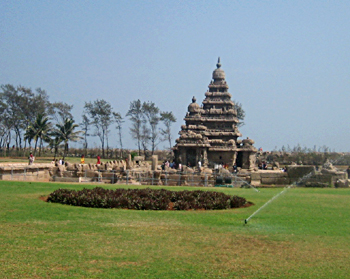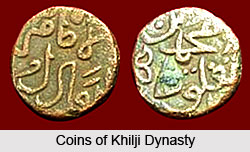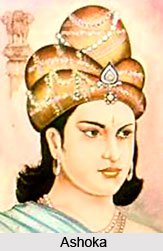 British employed the strategy of emotional and intellectual colonization in India, to consolidate the political colonization. It was the affinity of the elite section of Indian society to English culture, ideology and education, which facilitated the British to psychologically harness the nation`s mindset. Literally speaking, the British wanted the malleable Indians to learn, speak and believe English and become shadows of Englishmen. The Charter of 1833, English was announced to be the official language.
British employed the strategy of emotional and intellectual colonization in India, to consolidate the political colonization. It was the affinity of the elite section of Indian society to English culture, ideology and education, which facilitated the British to psychologically harness the nation`s mindset. Literally speaking, the British wanted the malleable Indians to learn, speak and believe English and become shadows of Englishmen. The Charter of 1833, English was announced to be the official language.
The cunning colonial government selected the education system as the instrument for hitting the target. Since 1813, the planned enterprise started, and was given a precise dimension, with the formulation of Macaulay`s "Minute" in February 1835.
The "Minute" was an intended trick. It wore the mask of general welfare, broadcast under the banner of educational advancement. "Minute" recommended the advent of Western learning as beneficial:
"For the revival and promotion of literature and the encouragement of the learned natives of India, and for the introduction and promotion of a knowledge of the sciences among the inhabitants of the British territories."
The politics lurking behind the objective of the "Minute" is evident in the scheming Macaulay`s clarification: "We must do our best to form a class who may be interpreters between us and the millions whom we govern, a class of persons Indian in blood and color, but English in taste, in opinions, words and intellect." The British were actually looking for services that would not only be inexpensive, but also efficient. And the suitable ones were the colonized Indians. Macaulay was dreaming of breeding an economically flourishing colony, generating enormous wealth as well as cheap labor.
The arrogant and racist Macaulay asserted the British ideology of the superiority of Western learning over the oriental reserve of knowledge. His condescending evaluation of Indian tradition and level of education, is reflected in his derogatory remark:
" …who could deny that a single shelf of a good European library was worth the whole native literature of India and Arabia". "It is, no exaggeration to say, that all the historical information which has been collected from all the books written in Sanskrit language is less valuable than what may be found in the most paltry abridgments used at preparatory schools in England".
The colonial master`s urgency for a uniform and proper administration throughout the colonial empire spawned the emergence of a class of clerks and translators. In the major presidencies of Bengal, Madras and Bombay, the British government had to rely on the ability of the District Judges and Collectors, for handling the administrative affairs, while the native princes functioned as per as the instructions of the colonial authority. A big administrative issue was the exaction of land-revenues from the indigenous farmer-class.
The overriding sense of separation in these foreign administrative officials and subordinate native rulers from the mass was making situations pretty difficult for the British. British decided to feel the pulse of the nation, through the effective medium of an English educated, servicemen`s class. This section of the clerks would act as the mediators and convey to the two poles- British and the general people, their messages. Moreover, the exorbitant cost of maintaining British officials was exerting a toll on the British Government. They were aware of the profitable prospect that the colonized natives bore for them. Ideally therefore the Indian employment incurred in much fewer expenses.
The success of the plan was soon witnessed. The recruitment of Indian brains in the junior posts of British administration, reaped in the rich harvest of government income, around, £30 million, of which £16.7 million was produced from land revenues, only.
The negative repercussion of English education, was the evolution of the Babus or the Anglicized identity-less Indians, deprived of the traits of the Indian heritage. This new cult of Babus, was given impetus by the Lord Hardinge`s diplomatic assurance given in 1844. Hardinge convinced that government would give priority to the natives furnished with English knowledge, in terms of government jobs.
 Nevertheless, the true intellectual Indians, like Pundit Ishwarchandra Vidyasagar, imbibed in the illumination of Western learning, while preserving, simultaneously the inherent Indian ness associated with him. . His exposure to the rational attitude of the Western philosophy, the ideology championing the rights to liberty, equality and fraternity, the scientific inventions and theories, invited the dawn of consciousness on him. He utilized the Western scientific, rational and intellectual thought to complement the oriental sense of respect for tradition and culture, and the cohesive pro-life force innate in Hinduism. But Hinduism over times had got polluted with blind, meaningless superstitions. He aimed at cleansing the Hindu religion and society of harmful customs. The Enlightened Vidyasagar innovated modern and liberal modifications, like widow-remarriage. Similar were the instance of the educated Rammohun`s memorable contribution in the abolition of the atrocious ritual of Sati and the rescue of the Indian womanhood from intolerable torment.
Nevertheless, the true intellectual Indians, like Pundit Ishwarchandra Vidyasagar, imbibed in the illumination of Western learning, while preserving, simultaneously the inherent Indian ness associated with him. . His exposure to the rational attitude of the Western philosophy, the ideology championing the rights to liberty, equality and fraternity, the scientific inventions and theories, invited the dawn of consciousness on him. He utilized the Western scientific, rational and intellectual thought to complement the oriental sense of respect for tradition and culture, and the cohesive pro-life force innate in Hinduism. But Hinduism over times had got polluted with blind, meaningless superstitions. He aimed at cleansing the Hindu religion and society of harmful customs. The Enlightened Vidyasagar innovated modern and liberal modifications, like widow-remarriage. Similar were the instance of the educated Rammohun`s memorable contribution in the abolition of the atrocious ritual of Sati and the rescue of the Indian womanhood from intolerable torment.
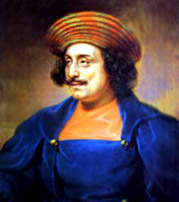 Indeed, the native reformists performed the feat of pioneering the English Education. The Hindu College in Calcutta, established in the year 1817, authenticated the ushering of the Bengal Renaissance. The foundation Committee was presided over by the stalwart, Raja Rammohun Roy. On October, 1853, a proposition was made, that "the College should be open to all youths of every caste, class or creed…". Accordingly it was renamed Presidency College in 1855 . This was done to allow non Hindu students like Muslims, Christians, Jews, Buddhists and followers of the Brahmo Samaj to attain the light of education. In 1857, Presidency College was incorporated under the governance of the educational headquarters, the University of Calcutta .
Indeed, the native reformists performed the feat of pioneering the English Education. The Hindu College in Calcutta, established in the year 1817, authenticated the ushering of the Bengal Renaissance. The foundation Committee was presided over by the stalwart, Raja Rammohun Roy. On October, 1853, a proposition was made, that "the College should be open to all youths of every caste, class or creed…". Accordingly it was renamed Presidency College in 1855 . This was done to allow non Hindu students like Muslims, Christians, Jews, Buddhists and followers of the Brahmo Samaj to attain the light of education. In 1857, Presidency College was incorporated under the governance of the educational headquarters, the University of Calcutta .
Presidency College has the proud history of permitting access to female students. In fact , the first female student joined the instituion in 1897.
However, documents report that the Hindu College, the celebrated seat of learning, was the right place for the making of the perfect know-how for the government assignments of the East India Company.
One must note that the blossoming of Western education happened due to the funds flowing in from the opulence of the affluent Indians. The truth applies to the history of the Hindu College and other institutions of the same pattern, for the first twenty-thirty years.
The atmosphere was abuzz with the brewing contest among the schools of Western learning and the centers of traditional subjects, namely, Sanskrit, Persian, and Arabic. In the first three decades of the twentieth century Hindu College and similar schools throughout British India depended on the patronage of wealthy Indians and were in direct competition with traditional schools teaching Sanskrit, Persian, and Arabic. As economic patterns changed, patronage for traditional schools disappeared. At about the same time, bright young men decided to study English.
Meanwhile, the Christian missionaries marched forward to plant the flag of British Imperialism in India, under the humanistic camouflage of Educational Campaigns. They circulated the mantra of benefiting Western education. Their target was the elite Indian section of the society. It was so, because many prestigious families were enamored of the newness of English Education.
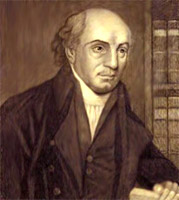 William Carey visited Bengal in 1800, and conducted the first missionary work in Srerampore of Bengal. With his two partners, Joshua Marshman (1768-1837) and William Ward (1769-1823) he formed the famous Serampore Trio. The Nathaniel Forsyth of the London Missionary Society also embarked on their operations from the Dutch town of Chinsura . And after the Charter of 1813, erased the ban on missionary- activities in India, even the Church Missionary Society came down India to spread its sway. In 1816, the church missionaries, Greenwood and Schroeter, made their way to Calcutta.
William Carey , the committed evangelist, was primarily interested in the advancement of the native vernaculars and literature.
William Carey visited Bengal in 1800, and conducted the first missionary work in Srerampore of Bengal. With his two partners, Joshua Marshman (1768-1837) and William Ward (1769-1823) he formed the famous Serampore Trio. The Nathaniel Forsyth of the London Missionary Society also embarked on their operations from the Dutch town of Chinsura . And after the Charter of 1813, erased the ban on missionary- activities in India, even the Church Missionary Society came down India to spread its sway. In 1816, the church missionaries, Greenwood and Schroeter, made their way to Calcutta.
William Carey , the committed evangelist, was primarily interested in the advancement of the native vernaculars and literature.
The Srerampore Trio tried to make education available, to the mass through the adoption of the native frameworks such as sardar-pado (monitorial system). They prescribed a curriculum consisting of arithmetic, preliminary science, synopsis of history, geography, natural philosophy, scripture and ethics. The curriculum was expanded to 103 elementary schools constructed for educational development. It was amazing enough, that by 1818, a total of 6,703 students studied in these schools.
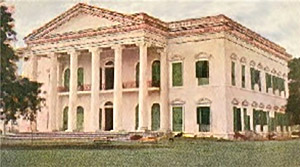 The greatest achievement of the Srerampore Trio is the foundation of the Srerampore College to patronize the proper cultivation of Oriental Literature and Western Sciences.
The Srerampore Trio recommended the modifications of some Hindu practices like the demeaning Caste System, the inhumanity of Sati, and Infanticide, to welcome a life of non-violence, equality and liberty. They sustained their combat against social evils, by legislating acts, forbidding these malpractices between 1804 and 1829.
The greatest achievement of the Srerampore Trio is the foundation of the Srerampore College to patronize the proper cultivation of Oriental Literature and Western Sciences.
The Srerampore Trio recommended the modifications of some Hindu practices like the demeaning Caste System, the inhumanity of Sati, and Infanticide, to welcome a life of non-violence, equality and liberty. They sustained their combat against social evils, by legislating acts, forbidding these malpractices between 1804 and 1829.
The London Missionary Society also fantastically accomplished in their project under Robert May. In 1814, 36 primary schools came into existence in Chinsura.
The Governor General, Lord Wellesley, carved out the Fort William College in 1800.
Along with this over brimming enthusiasm for education, resided the inclination for eminent translations of Bible into the oriental versions of Sanskrit,Oriya, Assamese, Bangla and Marathi. Indian scholars like Ramram Basu and Mrityunjay Vidyalankar, carried out the work with the foreign experts. Translations of the epic, Ramayana and other Indian classics were sculpted skillfully.
This path was followed by the Calcutta School-Book Society (1817), which upheld Bengali Prose to the helm of affairs.
Journalism became a widespread phenomenon. J. Marshman`s Digdarshan (the Direction Signifier), Magazine for Indian Youth, Samachar Darpan (the News Mirror), published in 1818 and The Friend of India (1818) revealed some social troubles present in the then social republic before the eyes of the British authority.
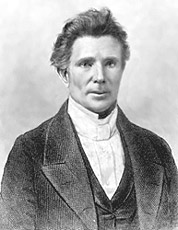 Alexander Duff (1806-1878), the famous Scottish missionary, stepped in Calcutta in May 1830. He was a key factor in the formation of the Scottish Church College, on July 1830. Duff is also found responsible for the conversion of enchanted Calcutta boys, for e.g. Mahesh Chandra Bose, Krishna Mohan Banerjee and a few more, into Christians.Thus conversion of the colonized into Christianity, was another motivation, playing behind the promotion of Western Education in India.
The liberal Raja Rammohan Roy supported duff`s educational efforts. However, Rammohan remained aloof from the religious mission of conversion. His Brahmo Samaj was an embodiment of his unique ideas, born out of a mixture of the healthy notions of Hindu religion and his own rules, meant for giving the momentum to his movement of social reform.
Alexander Duff (1806-1878), the famous Scottish missionary, stepped in Calcutta in May 1830. He was a key factor in the formation of the Scottish Church College, on July 1830. Duff is also found responsible for the conversion of enchanted Calcutta boys, for e.g. Mahesh Chandra Bose, Krishna Mohan Banerjee and a few more, into Christians.Thus conversion of the colonized into Christianity, was another motivation, playing behind the promotion of Western Education in India.
The liberal Raja Rammohan Roy supported duff`s educational efforts. However, Rammohan remained aloof from the religious mission of conversion. His Brahmo Samaj was an embodiment of his unique ideas, born out of a mixture of the healthy notions of Hindu religion and his own rules, meant for giving the momentum to his movement of social reform.
Female Education however did not rise to to that much of prominence, as it should have been. No matter how publicly British tried to advertise the importance of the growing "woman question", dealing with the rights of females, the actual scenario was much different. It was the native glory, Pundit Ishwarchandra Vidyasagar who opened 30 schools to boost up female education all over Bengal.
Still, one cannot deny the role of the unmarried female missionaries who crowded in India to elevate the status of the downtrodden women and children. They taught the women their value through education. Their way of imparting education was through narration of stories in the domestic space of the households. Women learnt the art of needlework, not only for daily family use, but also for earning livelihood. Christian Missionaries very wittily manipulated the adult Indian women to embrace Christianity.
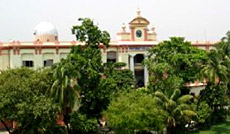 However, success was very limited. The reason was that women were dominated by the male who were the law-makers .
The wave of Western Education yet did not die away. British India, got its final platform for the spread of Western Education, when the Wood`s Despatch was structured in 1854. The Despatch,, promised to provide grant-in-aid for the amelioration of the private educational institutes.
History, reports that the schools flourishing under the industrious Bengali reformers surpassed the missionary-schools by virtue of quality. Cathedral Mission College (1865) was in no way a match for the indigenous symbol of educational perfection, the Presidency College (1855).
However, success was very limited. The reason was that women were dominated by the male who were the law-makers .
The wave of Western Education yet did not die away. British India, got its final platform for the spread of Western Education, when the Wood`s Despatch was structured in 1854. The Despatch,, promised to provide grant-in-aid for the amelioration of the private educational institutes.
History, reports that the schools flourishing under the industrious Bengali reformers surpassed the missionary-schools by virtue of quality. Cathedral Mission College (1865) was in no way a match for the indigenous symbol of educational perfection, the Presidency College (1855).
The strife for superiority continued. James Long, the noble British, together with the Missionary organizations kept alive the zeal for dissipating education among the mass. Finally, the Hunter Education Commission (1885) officially sanctified their resolution to attain mass education.
It is worth realizing the truth, that the British might have credited themselves as harbinger of Western Education in India, but then all their efforts would have been in vain, had not the brilliant Indian intellectuals, not been able to capture its essence. The Indians had the radiance of merit to not only cope with Western learning, but also increase its treasure with their precious literary contributions, and scientific inventions. Today, it is the Indians, who rule the domain of global science, a field of knowledge, which was once the prerogative of the Westerners.


